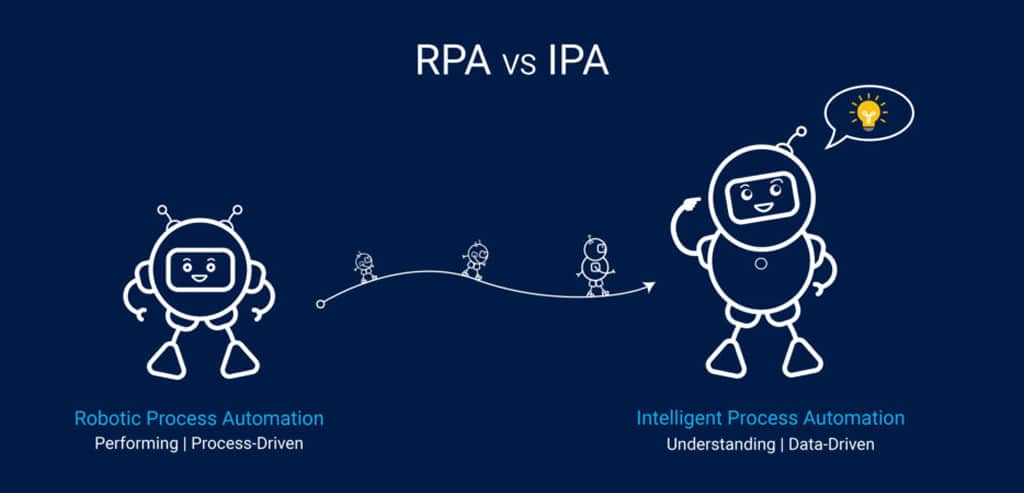If you Google ‘the difference between robotic process automation (RPA) and intelligent process automation (IPA) it’s easy to see why there’s some confusion surrounding both technology applications.
First, the technology at its core is still in the early adopter phase, which means many business leaders have yet to dive into what this technology is let alone understanding its differences. Despite this, a recent survey from Deloitte predicts a near-universal adoption of RPA by the year 2023.
Second, while RPA and IPA perform differently, they actually work well as a team. Given that this pairing is likely to create more confusion regarding the individual function and purpose of these bots, there are important yet simple points to address in order to increase consumer understanding.
The simplest way to put it is to think of RPA as ‘the engine’ in your car and IPA as ‘the driver’ of the car. RPA does what it has been built to do – burn fuel to move the car. IPA, or “the driver” is the intelligence in the car that has learned how to effectively drive it from point A to point B in the safest and most productive way possible. Now that we’ve gained a basic understanding of RPA and RPI, let’s take a deeper dive by distinguishing their fundamental characteristics.
The nuts and bolts of RPA
Think of RPA as the muscle behind your workforce: A highly reliable and fast-paced worker that accurately follows given direction. Not only will RPA strengthen your work force’s out put, it can actually add significant value by eliminating human error during repetitive, daily tasks. RPA will help your business increase its output by doing the following:
RPA can:
- Mimic pre-defined tasks with structured data like numbers
- Speed up processes
- Eliminate human error and increase accuracy
- Be implemented before IPA or at the same time
When you have data that has clearly defined structure, it’s the perfect scenario for RPA. Put in a real use case, say you have a finance department that has to collect the same data each month for a report. This may take them a few hours to pull all the data together from various systems… 3 hours a month x 12 months a year = 36 hours. Almost an entire work week of the year is spent just pulling the data for these reports. Not a lot of fun for your employee, not to mention you’re paying them nearly a full week’s pay just to pull data. This doesn’t even account for the potential for human error and the time spent fixing those errors. Ouch!
With RPA, the process of pulling the data can be automated in much less time (think matter of minutes) while also removing the element of human error. Not only will RPA improve precision, but it also frees your workforce of mundane, tedious tasks and enables staff to instead focus on creativity, collaboration and growing the business. There are limitations to RPA…
RPA cannot:
- Analyze data
- Learn from the process to improve it
- Work with undefined data such as images
- Suggest other items in a process sequence
- Understand context
But where these limitations end RPA’s capabilities, they give way for IPAs great strengths to take over.
The nuts and bolts of IPA
IPA uses cognitive automation which means the bot actually learns as it works, which assists in the more complex analysis and decisions RPA is unable to handle. In reality, these two technologies work complementary to each other.
While RPA can work to enhance your current repetitive processes, IPA will work to improve them with its intelligent learning abilities. Handling more complex requests, IPA uses techniques like natural language processing (NLP) and machine learning to produce advanced outputs that closely mimic human interactions themselves.
IPA can:
- Handle unstructured data like images or text
- Can turn unstructured data into structured data for RPA to work with
- Understand context
- Simplify processes
- Continually learn & iterate
With RPA and IPA technologies working in synchronicity at your fingertips, the scalability of your business is able to reach new heights never before possible.
The EPSoft Intelligent Automation Platform, allows companies to manage the entire RPA lifecycle using a single cohesive platform. With this everyone can easily access and leverage multiple processes from one console, ultimately saving time and effort across the board.
Curious as to how RPA can be implemented within your organization? Check out our blog, Why RPA: 5 Use Cases for Robotic Processing Automation All Business Leaders Should Know and contact us for a free analysis of your business!

